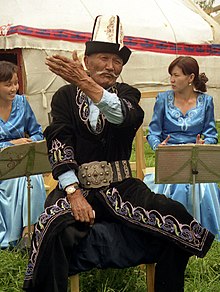
Back الحفاظ على التاريخ الشفهي Arabic Oral history preservation English Zachowywanie historii mówionej Polish

Uhifadhi wa fasihi simulizi ni juhudi zinazofanywa kwa makusudi ya kuhakikisha kazi za fasihi simulizi[1] zisisahaulike na hatimaye kupotea kabisa.
Kazi hizo zimeanza tangu binadamu walipoanza kupambana na mazingira yao ya kuishi pamoja[2]. Kazi hizo zilisimuliwa na kuakisi shughuli zilizokuwa zikifanywa na watu katika mazingira ya wakati huo. Kadiri mazingira yalivyobadilika hali kadhalika mambo yaliyokuwa yakisimuliwa ndivyo yalivyokuwa yakibadilika. Hivyo, kulikuwepo na haja ya kuhifadhi kazi hizo kwa faida ya vizazi vipya[3].
Katika kuhifadhi kazi hizo, kuna njia mbalimbali zilizotumika tangu kale na nyingine zinazotumika leo kwa kufaidika na maendeleo ya teknolojia[4]. Njia hizo ni:
(a) Kichwani / Akilini
(b) Kwa maandishi
(c) Kwa vinasa sauti
(d) Kwa kanda za video, runinga na tarakilishi
- ↑ https://www.britannica.com/topic/oral-tradition Oral Tradition, Encyclopædia Britannica, John Miles Foley
- ↑ Henige, David. "Oral, but Oral What? The Nomenclatures of Orality and Their Implications" Oral Tradition, 3/1-2 (1988): 229-38. p 232; Henige cites Jan Vansina (1985). Oral tradition as history. Madison, Wisconsin: University of Wisconsin Press
- ↑ Conservation of cultural heritage involves protection and restoration using any methods that prove effective in keeping that property in as close to its original condition as possible for as long as possible
- ↑ While reel-to-reel audio tape recordings are still used, video recordings have become standard. This allows the researcher to take body language and facial expressions (both important means of communication in themselves) into account. There is also an emerging trend to use the telephone to make audio journals when distance prevents face-to-face contact. In order to ensure the preservation of oral histories it is important that all work is properly transcribed and stored on reliable media. It is important to preserve oral histories in modern digital format to ensure longevity and usability. The simplest and easiest way to do this for audio histories is to purchase a "personal MP3 player" that has recording capabilities, and record directly to the flash chip in the player. These are very inexpensive and can hold many hours of interviews. The files should then be uploaded to a central computer server and copies can be burned to optical media, or copied to USB flash drives owned by the researchers, scholars and students working with the material. Recordable compact discs are commonly used over magnetic tape for the preservation of oral histories over a long period of time. Compact Cassette tapes and Videotape were popular but have been almost completely replaced by optical media such as CD-R and DVD media. CD-R is a successful technology that has proven its reliability over period of time, but it should be viewed with caution for long term storage as the media is easily scratched. The safest way is to make a "gold master" CD that is not ever checked out for use from the library, and duplicate copies of this for use by people wishing to access it. The Folk Heritage Collections, at the Library of Congress, set a standard for 24 bits when digitizing music. This creates "superb" sound and has a high level of detail (Danielson, 2001). The Library of Congress uses CD-R as one of its storage methods. The Library of Congress has a higher budget than many university or archives, therefore they are able to store materials in multiple places. But, the Library of Congress has stated that they do believe storing sound on CD-R is a safe storage method (Danielson, 2001). One can assume if it is considered safe by the Library of Congress it is a relatively safe method of preservation. A huge challenge of oral history preservation today is the battle with digital obsolescence. There is an obvious link between oral history preservation and digital preservation. Oral histories are often recorded on an assortment of tapes which are ultimately transferred onto computerized, or digitized, formats in order to facilitate their longevity. These digitized formats then have to be preserved, along with their corresponding metadata, just as any other digital objects are. Technological advances are happening everyday and it is difficult to keep up with these changes. Emulation and migration are two ways in which formats can be changed in order to be of use for longer. Emulation focuses on designing hardware and software that will imitate the old system so that it can accept the old files while migration focuses on fitting preserved data into a smaller number of formats that can still encode the complexities of the structure and form of the original format. Cfr. Soete, G.J. (1997). Transforming libraries: Issues and innovations in preserving digital information. Washington, DC: Association of Research Libraries. With the recent cost decreases in hard disk drives, oral archivists are considering moving many of their popular holdings to permanent storage in a server farm. For example, a single terabyte disk drive costing under $100 USD can hold 1,900 hours of uncompressed audio. A CD-R by contrast can only hold 76 minutes of uncompressed audio. Disk drive array cards such as the 3ware 9650SE can field 8TB of redundantly protected data in a standard PC case. One of the big advantages of doing this is that as the servers age and are retired, the files can simply be copied to newer, larger replacement servers making hardware obsolescence a thing of the past.